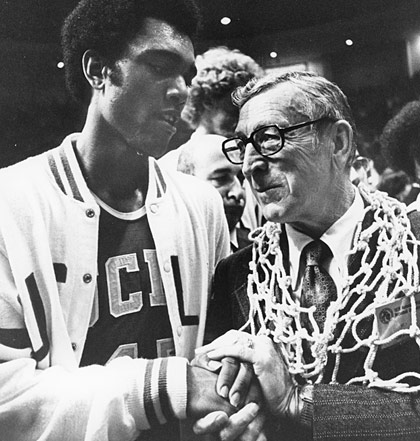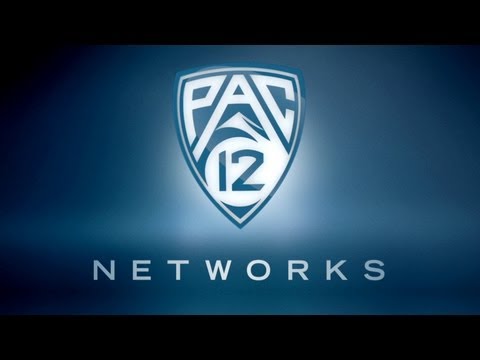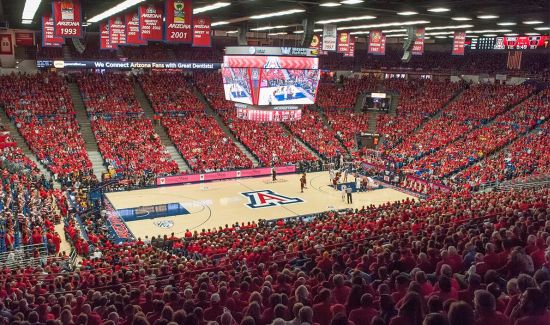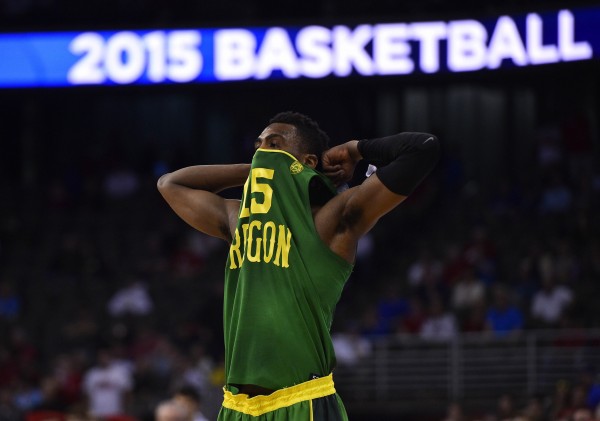The Pac: Way Back?
Posted by Andrew Murawa on April 2nd, 2015Three Sweet Sixteen teams. One in the Elite Eight. And yet when the Final Four rolls around this weekend, it will commence without an entrant from the West Coast’s major conference, the Pac-12, for the seventh consecutive season. Arizona has nothing to be embarrassed about from its loss to Wisconsin on Saturday. Utah and UCLA both put up good fights before going down to clearly superior teams. But this is turning into something of an issue. Since the last time a Pac-12 team advanced to the Final Four (UCLA, 2008), four different Big Ten schools have earned a total of seven spots in the sport’s final weekend. The Big East has earned seven as well, although all of those but Villanova have scattered in the wind to different conferences (the new Big East does have Butler, however, which earned two Final Four appearances as part of the Horizon League). Even conferences like the Colonial (VCU, 2011), the Missouri Valley (Wichita State, 2013) and the newly formed American (Connecticut, 2014) have Final Four appearances since the last Pac-12 appearance.
Furthermore, if you throw out UCLA’s three straight appearances from 2006-08, you have to go all the way back to 2001 to find another Pac-12 school (Arizona) with a Final Four appearance. In the history of the conference that starts with the word “Pacific” and ends with a number, only three schools (UCLA, Arizona and Stanford) have made the Final Four. Current member Utah got to the final weekend back in 1998 (and in 1966, for that matter) as a member of the WAC, and had previously earned spots as a member of the Mountain States conference in 1944 and 1961. Refer to the bottom of the page for the complete list of when teams in the conference last reached that level of success. So, really, I didn’t sit down expecting to write the above. I was just going to write a simple season wrap-up and wound up diving down a rabbit hole. Now I’m left with these burning questions: 1) Why does the Pac-12 find itself in such dire straits? And 2) is there any hope of significant change? Let’s dive right into the first one with the caveat that, even after thinking about this for 24 hours, I’m not sure I have a great answer. So, we’ll leave it open for further discussion. Feel free to shoot down any of my theories and propose your ideas along the way.
Let’s get right to the point. There are two Pac-12 college basketball programs with any sustained level of success: UCLA and Arizona. UCLA’s greatest success goes back to the ’60s and the ’70s, beginning with John Wooden’s steady build of the program upon his arrival in 1948. And while there is only one banner hanging in Pauley Pavilion from the last 40 years, there are 30 NCAA Tournament appearances and five other Final Four appearances since his retirement. But in the nascent years of the sport’s national growth, is it possible that UCLA’s utter Pac-dominance for two decades (in the 20 seasons from 1960-61 to 1979-80, UCLA won the regular season Pac title 17 times) prevented the development of a rival program capable of challenging it? Its only legitimate conference rival on the national stage has been Arizona, which joined the conference just after the era of Wooden’s dominance had ended (1978). Under Lute Olson (who took over in Tucson in 1983 and coached until 2008), the Wildcats won 11 regular season titles, advanced to four Final Fours and won one national title (1997). So, at the time when the big redwood’s shadow had lessened a little and allowed for all the other little sprouts on the forest floor to get some sun, it was Arizona that grabbed all of the nutrients and grew into the next national power, leaving the rest of the conference largely fighting for scraps.

Did John Wooden’s Dominance Hamper the Growth of Other Conference Schools at an Important Time in the Sport’s Growth?
My second thought was simple: geography. There are simply more people living in the eastern half of the country. That effectively means more recruits who want to stay close to home and correspondingly weakening the safety net for western schools. For instance, when Washington missed out on northwestern kids like Terrence Williams, Peyton Siva, Terrence Jones, Kyle Wiltjer, Enes Kanter and Shaqquan Aaron over the course of a decade to schools residing in the Commonwealth of Kentucky, those misses weren’t easily replaced by a program that has trouble recruiting nationally. This means that the recruiting stakes on any one elite prospect are higher in the west. Furthermore, when an upstart from a smaller western conference – think UNLV, Gonzaga or San Diego State – comes along and starts getting a fair number of those quality recruits as well, that further limits an already constrained talent base. Back east, coaches can easily expand their recruiting diameters and roll with the punches; out west, it’s not as easily done.
The other issue with Pac-12 geography is that, for the most part, these schools are in major metropolitan markets where they are competing for entertainment dollars with professional teams in a variety of sports as well as arts and culture and a ton of other things to do. No offense to Lexington, Bloomington, Lawrence, Chapel Hill, Syracuse and East Lansing, but on any given night in Los Angeles, the Bay Area, Seattle, Phoenix, and so forth, there are generally more entertainment options. As a result, fan support in those locations will never be for college sports what it is in those places. We like to make fun of the sparse crowds in Pauley Pavilion for a normal January game, but the fact is that the average person in Los Angeles has plenty of other options to spend his entertainment dollar than at a Bruins basketball game. USC basketball? Even further down the list. As a result, the home environments for Pac-12 basketball outside of the very biggest games are not always thrilling places. Maybe that contributes to situations where those Seattle kids feel compelled to opt for the more raucous home environments in places like Kentucky. Which, in turn, leads to a lesser product on the court. Which, to play it out, leads to even fewer fans in the stands. An offshoot of this vicious cycle is that it also leads to less internal and external pressure on the program to consistently put a quality product on the court. And, of course, fewer butts in the seats equals fewer hot dogs purchased at the concessions stands and fewer jerseys sold. Simply put: less money all the way around.

The Pac-12 Networks Have Been a Cash Cow But Schools Need to Spend Money on Basketball to Win There Too
Money is definitely an issue as well. Much hullabaloo was made over the $3 billion television contract that the Pac-12 signed with promises of many millions for each of the schools around the conference. And those numbers have been borne out for the most part. But you know what? The SEC still makes more money per school. The Big Ten, likewise. Money’s not everything, of course, but it can do plenty when it comes to upgrading facilities and paying head coaches. Alabama, a school with little in the way of a sustained basketball history, was willing to give Wichita State’s Gregg Marshall a blank check, and after Wichita and the Koch brothers fought off that incursion, they’ll throw big sums at their next target. At the same time as programs like Auburn, Tennessee and Mississippi State are willing to pay big dollars to upgrade their programs. In the Pac-12, UCLA and Arizona pay their coaches well (Steve Alford and Sean Miller both make better than $2.5 million a season, ranking among the top 10 salaries in college basketball) while Oregon, awash in Nike money, pays Dana Altman about $2 million annually.
This combination of a lack of emphasis on basketball, fewer available funds than some other power conferences and tougher recruiting grounds may have brought us to a point where the conference also lags behind in terms of coaching talent. Certainly Miller is a star and Altman consistently gets the most out of his team. Beyond those two, in a sport that is most assuredly a coach’s game, there are a lot of question marks. I maintain that Alford is a very good coach but his salary puts him in the same range as more successful stars like Billy Donovan, Tom Izzo, Thad Matta, Jay Wright, Bo Ryan and Tony Bennett. Larry Krystkowiak is a rising name in the coaching profession, but he averages about $1.66 million per season on his current contract. Wayne Tinkle is a downright bargain at $1.1 million per year, but every other coach in the Pac-12 has more questions than answers.
Compare the Pac to the SEC. The Pac-12 has probably been a slightly better top-to-bottom conference than the SEC over the last decade, but what about over the next decade? The SEC currently boasts John Calipari, Billy Donovan, Rick Barnes, Ben Howland, Billy Kennedy, Bruce Pearl, Frank Martin, Andy Kennedy, Mike Anderson, and Kevin Stallings as head coaches, with Alabama poised to pay somebody a ton of money to join that strong group. The Pac-12? Johnny Dawkins, Lorenzo Romar, Ernie Kent, Andy Enfield, the vacant spot at Arizona State and SEC discard Cuonzo Martin do not collectively inspire much confidence. As Adam Butler of Pachoops.com pointed out in a discussion about this current state of affairs, there is a bit of a chicken and egg type of thing going on. Should fans come out and support middling products when the administrations at these fine universities make uninspiring hires and hang on too long once momentum is lost? Should they care about a Trojans-Golden Bears game when they could instead take in an NBA battle or a concert or spend an 80-degree January afternoon at the beach instead of in the Galen Center? Or do the fans need to show their support and concern for the program in order to prod those administrators to become better caretakers?
There are no easy answers. It is probably a confluence of several different factors that has led us to this point, with my favorite standby of plain old-fashioned bad luck (and East Coast bias!) mixed in there to some degree. But back to my second question: Is there any hope for change? Of the four Pac-12 teams that made the NCAA Tournament this season, Arizona is going to lose an as-yet-undetermined chunk of their team (Rondae Hollis-Jefferson is already gone). Oregon loses conference Player of the Year Joseph Young. Utah says goodbye to Delon Wright (and maybe more). UCLA loses Norman Powell and likely Kevon Looney. Several other stars around the conference will depart as well. In other words, if you’re looking to build on the whole three Sweet Sixteen teams thing from this year, you may want to shield your eyes a bit come next season.
In the long run, Arizona’s program appears rock solid. At some point, maybe anther big-time school like Kentucky or Duke could come in and steal him away, but there are better-than-good odds that Miller is merely in the very early stages of a long and successful career in Tucson. UCLA? The state of the Bruins’ athletic department and their fan support is a mess, but they’re still a blue-blood program in a great location that can lock up local kids and recruit nationally; in other words, don’t expect the Bruins to completely fall off the face of the earth anytime soon. But for the Pac-12 to approach a level where multiple programs can realistically compete for a Final Four every now and again, the league will need to see some of (if not all of) these programs take a significant step forward.
- Oregon: New arena; Nike money; cool factor carrying over from football; terrific head coach; and a ton of institutional support. The Ducks are the program best-positioned to make a run at the clear-cut #3 spot in the conference.
- Stanford: The Cardinal made the NCAA Tournament 13 times in 14 years between 1995 and 2008 with one Final Four, one Elite Eight and two Sweet Sixteens during the run. This program can succeed. And given the community’s rabid support for its women’s team, there is a possibility of fan support there. Over that successful span they had a Hall of Famer in head coach Mike Montgomery followed by another solid head man in Trent Johnson. Johnny Dawkins continues to get more chances in Palo Alto, but his margin of error is running slim.
- Washington: It wasn’t more than maybe five years ago when the Huskies were the obvious #3 program in the conference. But over the past half-decade, momentum in Seattle has completely stalled out. Lorenzo Romar has a fine recruiting class entering next year and it may represent his last chance to revive a once-promising program. With a good location and solid facilities, the Huskies have a chance to get back to national relevance.
- Utah: Larry Krystkowiak is a rising star. He’s at a program with a ton of outstanding history in a basketball-mad state. He’s got a strong homecourt advantage. He’s in a situation where he could take advantage of the lean times and ramp up his school’s momentum.
- California: We still don’t know what to think of Cuonzo Martin, but if he lands a big recruiting class highlighted by five-star center Ivan Rabb, that could prime the pump for years to come. There is plenty of talent in northern and central California for Martin to keep the Bears stocked with talent, but the fact that success hasn’t ever been sustained in Berkeley (even under Mike Montgomery) is reason for pause.
- USC: For a program with no real history of recent basketball success (16 total NCAA Tournament appearances, six total NCAA Tournament wins since 1980), the Trojans are still regarded as a sleeping giant, in some ways similar to like-minded Alabama. On a football-first campus, the Trojans’ athletic program is excellent in nearly every area except basketball. But USC has excellent facilities. It’s got fertile recruiting grounds nearby. It’s got a national brand. Just look at what Andy Enfield is doing in the recruiting wars. Still, until recruiting wins start turning into real wins, USC is generally considered a an afterthought.
** Oregon State went to the Final Four in 1963 as an independent (and in 1949 as a member of the Pacific Coast Conference). California went to back-to-back Final Fours in 1959 and 1960 (as members of the Pacific Coast Conference and the AAWU, respectively) and in 1946 (PCC). Colorado went in 1955 (Big Seven), USC in 1940 and 1954 (Pacific Coast), Washington in 1953 (Pacific Coast), Washington State in 1941 (PCC) and Oregon in 1939 (PCC). Long story short: Our conference is not a conference with great and varied success in college hoops.












































